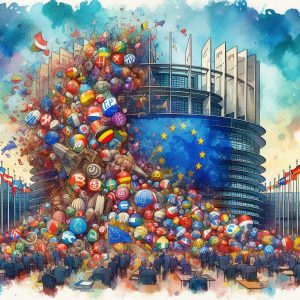
Pooling information from official EU websites can offer data-driven insight and enhance digital campaigning tools. However, retrieving, and relying on such sources creates numerous challenges for campaigners due to lack of consistency and standardisation of how information is presented. At FTSQ we are currently going through the published data about the recently elected MEPs. Before what’s out there can be successfully used for your next campaign, a vast review and standardisation is needed. And we’re on it.
of EU groups and national parties
Pretty much everything in the European Parliament is officially organised by groups, that are almost like european parties (socialists, christian democrats, liberals, greens…), but not quite. for instance, the votes are separated by groups. A lot of advocacy and analysis in the EU bubble is done using groups as the primary way to plan and hopefully get the laws you want.
However, this is definitely not how citizen organise their representatives, they don’t know eu groups, they know their national parties. We believe that to campaign better and help bridge the gap between the EU parliament and the citizen, we need to use national parties, not EU groups as much as we can in our online campaigns.
Naming system (or lack of one)
The European Parliament does not rely on a single list of national parties the MEPs belong to. MEPs provide the EP with their national party name as they wish (as opposed to, for example choosing it from a pre-prepared list) and it’s that name (without any standardisation process in the middle) which is later listed on their official EP profile. As a result, the names of the national parties assigned to individual MEPs are often inconsistent and often confusing.
The same party appears multiple times but with different spellings and in various languages. For instance, while some Polish MEPs are assigned to the Polish “Law and Justice” party, their colleagues from the same national party are listed as members of “Prawo i Sprawiedliwość” (“Law and Justice” in Polish). Some parties from Bulgaria write their name in cyrillic, some using latin letters recreating the Bulgarian spelling, others opt for the English version of the name. Diacritics and accents sometimes get lost. Some very long names (e.g. “Apvienotais saraksts — Latvijas Zaļā partija, Latvijas Reģionu Apvienība, Liepājas partija”) are used, while sometimes only shortened versions are deemed enough. Certain party names appear all in uppercase (see: FRATELLI D’ ITALIA). The more MEPs from a particular national party, the more potential for inconsistent naming which in turns makes pooling of the data increasingly time consuming.
Excluding the 14 independent MEPs, there are 208 listed national parties. 121 of them have more than 1 MEP and there are 14 parties with more than 10 MEPs (spread across most EP groups).
Coalitions
Some of the MEPs were on coalition lists, but after the election most seem to identify only with one coalition member party. Some choose to list the coalition name, especially if it is (or is desired to be) a long-standing alliance.
Same names
There are parties which have the same name in different countries. “Volt” in the Netherlands and Germany are indeed connected (while legally being separate parties), but on the other hand we have a “Parti socialiste” in France and “Parti Socialiste” in Belgium (which are entirely different parties).
Independent MEPs
20 MEPs don’t have a party, 13 have “Independent” listed as their party, a bunch “Indépendant”. Two more appear without any party name at all. There is also a “Sans parti” (“without a party”in French) MEPs. These independant MEPs belong to various groups along the political spectrum and some of them used to belong to certain parties but have since left.
How to handle far right
Some organisations we are helping have a policy of non engagement with the far right. This term is getting trickier to identify them, as they belong to 4 different groups, and some don’t belong to any party. We need to find better ways to sort that out, ideally before there is a rush for a campaign
Why is it a challenge for digital campaigning?
Inconsistent naming and organising of data about the MEPs makes it impossible to directly rely on the official information from the EP for your campaigning tools and efforts. The data can’t be simply retrieved and used in your database or campaign tool. At the same time, over the years we’ve observed that citizens are more likely to contact the MEPs in the course of digital campaigns if they can see which national party a given MEP belongs to. Supporters are more likely to think of MEPs in terms of national parties, as opposed to which EP group they belong to. Unfortunately, in the current shape, information presented by the EP cannot be used for digital campaigning tools in a straightforward way, instead it generates duplicates and errors.
What are we doing about it?
We are finalising a major update to our mail-to-target tool, which we believe will make citizens, even those who do not follow European politics closely, more likely to get on board. We have supported hundreds of campaigns targeting the MEPs in the past. What we are now adding to our tried and tested tool is a display of national parties on the list of targets. Each MEP will appear with both their EP group and national party affiliation. We are positive this will positively impact the conversion rates and ultimately the success of a campaign.
Please get in touch at: contact@fixthestatusquo.org if you would like to use our new, revised, mail-to-target tool or hear more about it.
